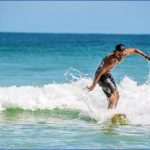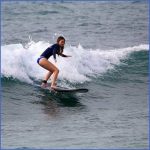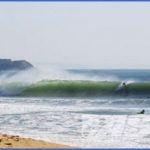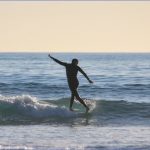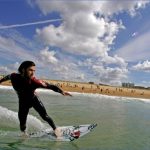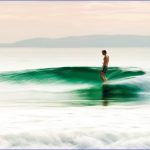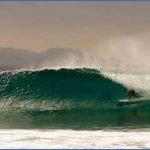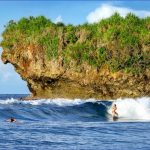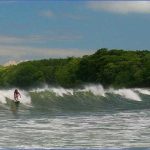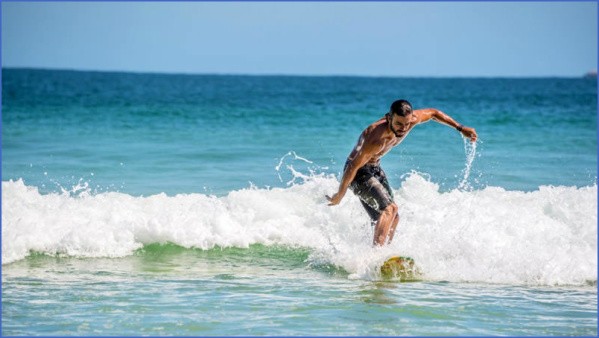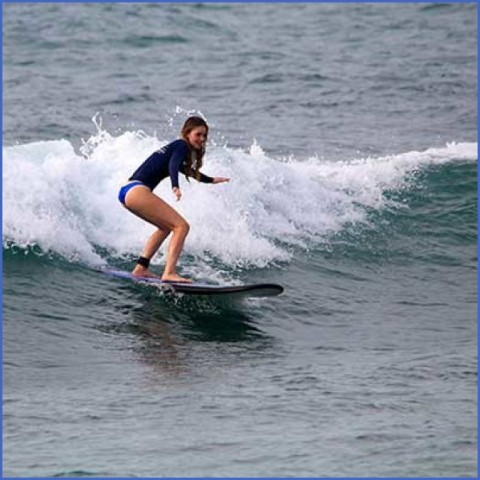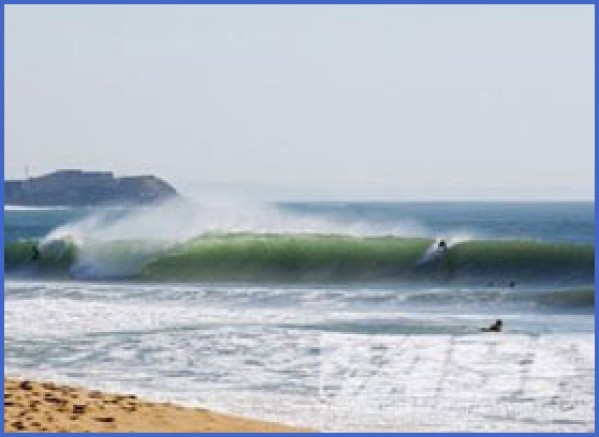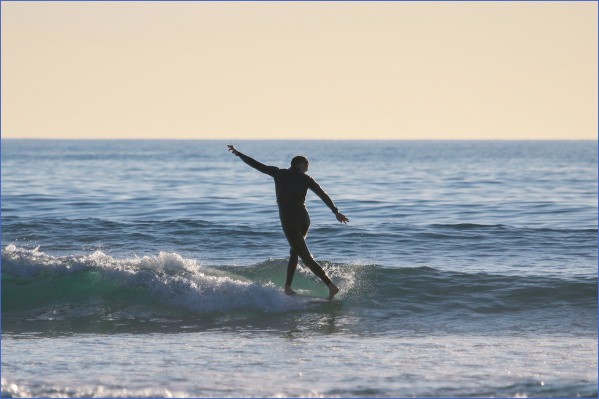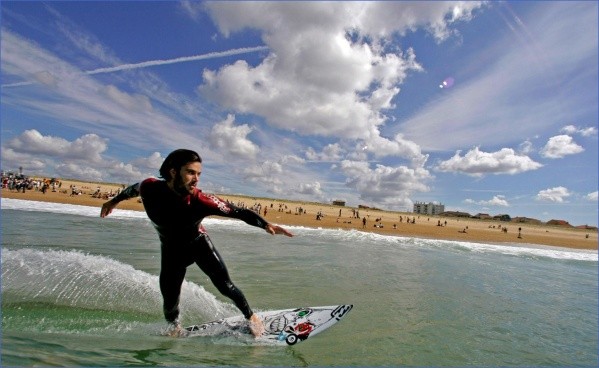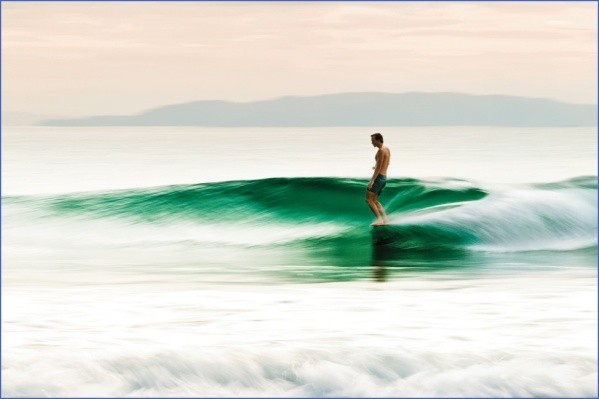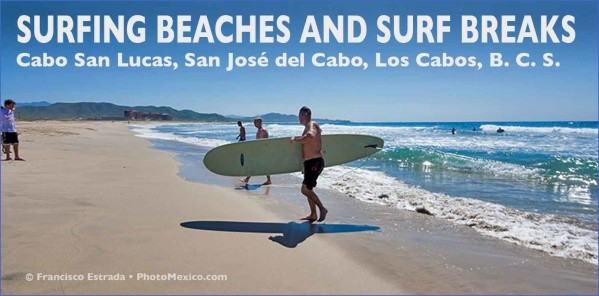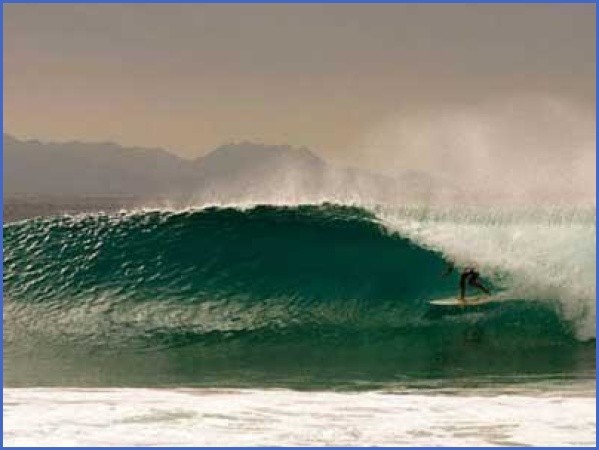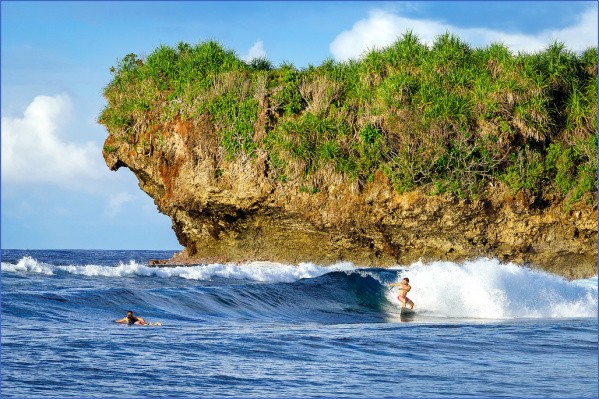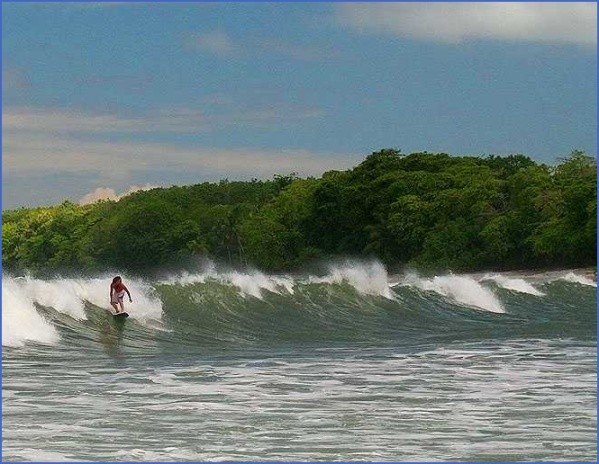Beeto yanks a hermit crab out of its shell, then lashes its live, writhing body to the hook using a piece of dried grass, and tosses it over. We troll for flying fish without a bite for nearly an hour; I’m sure I’ve brought along the woman’s curse.
Eventually, we manage to catch three flying fish. Each man hooks one to his trolling rig and we speed out to sea with them in tow. After another hour, the atoll is just a smudge on the gray horizon. The sky spits rain, and the sea churns with the mix of swells from all the squalls. Sitting with my back to the wind, the cold rain steadily pelts my rain jacket, interrupted by warmer dousings of seawater sporadically coming over the rail.
“We outside, but you still in the house!” Beeto says. Everyone bursts out laughing, comparing their useless ripped slickers to my head-to-ankle rain gear.
We soon catch a large wahoo, but the squalls and seas seem to be worsening. A failed engine would send us drifting toward the Gilbert or Marshall Island groups, 2,500 miles downwind. I praise myself for stashing a handheld GPS and VHF radio at the bottom of my dry bag.
As we fight our way back toward the island, we spot a lone man in an outrigger. His slender paddle is not enough against the vicious thirty-knot gusts. Using the thick monofilament tuna handline, we tie the outrigger to the back of the tinny and tow him into the headwinds. Shortly after, we spot another man in need of help, and soon we’re plowing slowly landward with both canoes in tow, looking like three body segments of a water-walking insect.
“I drift out to sea once,” Teuta recalls. “I float for three days.” My eyes widen. He grins and nonchalantly tells the tale of being blown offshore on a similarly windy day, and then being randomly spotted by a passing US Coast Guard plane that dropped him a life raft and gave his coordinates to a nearby ship. No one could be that lucky twice!
When I turn to check our progress, I’m relieved to see the island is now at a swimmable distance. We drop off the two fishermen and they each give Teuta a fish in gratitude.
Our next pursuit is tuna. We motor up to where we can see the reef rising from deep water. Teaboka drops an old drum brake for an anchor, and the tinny drifts back over the abysmal depths. Teuta opens a couple of coconuts for drinks and snacks. I pull out a bag of peanuts. The men are cautious at first, but finally dip into the bag and are immediately taken by the foreign delicacy. After puffing a pandanus-leaf cigarette and munching on more peanuts, raw wahoo, and coconut meat, the men’s thoughts turn back to fishing.
4 Incredible Beginner Surfing Destinations Photo Gallery
I look on as they rig their tackle. First, they cut meat from the wahoo into small pieces if the one knife aboard is being used, the others simply bite chunks right off the fish’s body and pile them in the center of one of the round leaves. Then they skewer a piece of fish with a large hook and put it inside the same leaf, folding the leaf edges up all around it. Next, they select a stone, and wrap the thick monofilament from the hook around both the folded leaf and the stone, turning it into a compact package. With a hoot for luck, it’s dropped over the rail and, as it sinks to around 300 feet, the fisherman gives a swift jerk on the line to open the leaf package, sending the stone to the seafloor and scattering the extra bits of bait to serve as chum.
Teaboka hooks the first tuna. The men work together in smooth unison pulling it to the surface, heaving it aboard, and killing the fish with three swift blows from a hand-carved club. I’m impressed at the size of the golden striped beauty, but to them it seems only a trifle.
I’m not quite ready to gnaw on the half-chewed, sun-warmed wahoo, so while the knife is free I slice some bait and try my hand at crafting one of the rock-and-leaf rigs. When I’ve finished, Beeto lets me use his handline. I wrap my creation in the thick monofilament and drop it over the side with my best version of the fish yelp. Not a minute goes by before it feels like I’ve snagged a sinking car. The monofilament wheels off the handline in hot stings across my bare hands. Luckily, I manage to keep the spool in the boat.
Once the beast tires a bit, I begin hauling it up from the deep. After ten minutes my arms burn, and I pass it off to Beeto. By the time the fish breaches the surface, all four of us have taken a turn heaving on the line. When the “big mama,” as they call it, comes over the rail she’s only slightly smaller than I am. Soon all three lines are back at 300 feet.
An hour passes with little action. Teuta hooks something, but it gets off. I curl into a blissful catnap on the bow until Beeto nudges me gently. “Leeess, Leeess. You try again,” he says.
I lug myself vertical and take hold of his line. Before I’ve fully regained alertness, there’s dead weight on the end of it, and another wild belaying of the monofilament. I pass off the handline and soon another big mama comes over the rail. It makes me sad to see the big beauties killed, but their meat, along with coconuts, is the main food source for the islanders.
When the men seem pleased with our catch, we head back. On the way, Teuta lops off the head of one of the great fish, reaches into its body, and pulls out the round red heart. Beeto and Teaboka grab at the lungs and other organs, gobbling them on the spot, but Teuta passes the heart to me with an air of honor. I’ve heard the fishermen’s legend about eating the heart of the tuna and, after such a day of bonding, I can’t let them down. I reach out and take the still warm heart in my hand and sink my teeth into it. The mildly nauseating moment is well worth the grand smiles of my proud new fishing buddies.
The following Saturday, I hear a knock on the hull in the early dawn hours.
“Haloooooo? Leeeeeesss?” I leap out of bed and come out of the cabin to see Teuta, Beeto, and Teaboka smiling and hanging onto Swell’s rail from the tinny.
“They want you to come fish with us again,” Teuta announces. “They think you very lucky.”
Soul-o Sessions
When the first south swells show up in mid-April, a beautiful wave breaks at the pass. From my cockpit, I sit and watch the mesmerizing lefts spin through, unridden. It’s every surfer’s dream to have a perfect wave all to him or herself on a tropical island. I wait for the slack tide, then motor over with my board in the dinghy.
I dive down and rig a small mooring in the channel, as the currents are strong and I don’t want my dinghy to be swept away. The scene is surreal as I paddle solo up the reef with flawless lines pouring in. I take a moment to observe, and then drop in on a shoulder to warm up. I hoot for myself as I drop in a little deeper each time and carve down the line. It’s nice not to be forced to sit deeper than my skills allow or to have to wait for the scrap waves the crowd doesn’t want. I can mess around and throw up a radical turn without worrying about wasting the wave if I fall.
Between waves, I think about how crazy it is that I actually made it into this moment. Peppered among the exhausting nights, lifting and hauling, ripped sails, clogged carburetors, perennial scrubbing of algae, persistent nausea, and unrelenting dampness are the moments like this for which my soul has yearned. As difficult as this voyage can be, there is something valuable in the process. Appreciation deepens for a prize earned through hardship. And every action along the way becomes sacred.
In the coming weeks, I grow more and more enamored with the solo sessions. But the risk of injury looms large in my mind. The consequences here are unthinkable. It’s not safe to push my limits alone with zero access to medical care and no one around. So I take my time choosing waves. No other surfers are coming out, and no one is watching. I don’t have to charge or “shred.” I force less and just enjoy myself changing up my stance, throwing my arms and smiling at the sky, or squatting low and leaning back into the face for another view. With ego removed, surfing is an entirely different experience.
I love to turn around and watch the waves breaking behind me. The pitch and curves of the lips are hypnotizing. Upon collision with the sea below, the wave explodes into bubbling foam. The turquoise sea rushes and blurs under my feet as I speed backward along the wave faces.
During these sessions, I surf for the feeling of freedom and unity, for the way the soft salt water caresses my skin and the sun warms my back, and to gaze at the ever-evolving clouds and majestic arcs of the wings of seabirds circling and diving around me. Each push of wave energy is a gift from the sea, from the wind, from the sun, from the whole miracle of our spinning planet and mysterious universe. Riding these waves feels more like worship than sport.
I feel both gratitude and guilt, watching men sail back and forth in their canoes, fishing for dinner for their families. Play seems so luxurious in a land where people spend all day just trying to eat. As the sun sinks, the sea blushes pink. Flying fish soar through the lineup, with tunas as big as golden retrievers bursting from the sea behind them in astounding, open-mouthed leaps. A tuna sandwich will never be the same.
Maybe You Like Them Too
- Top 10 Islands You Can Buy
- Top 10 Underrated Asian Cities 2023
- Top 10 Reasons Upsizing Will Be a Huge Travel Trend
- Top 10 Scuba Diving Destinations
- World’s 10 Best Places To Visit

